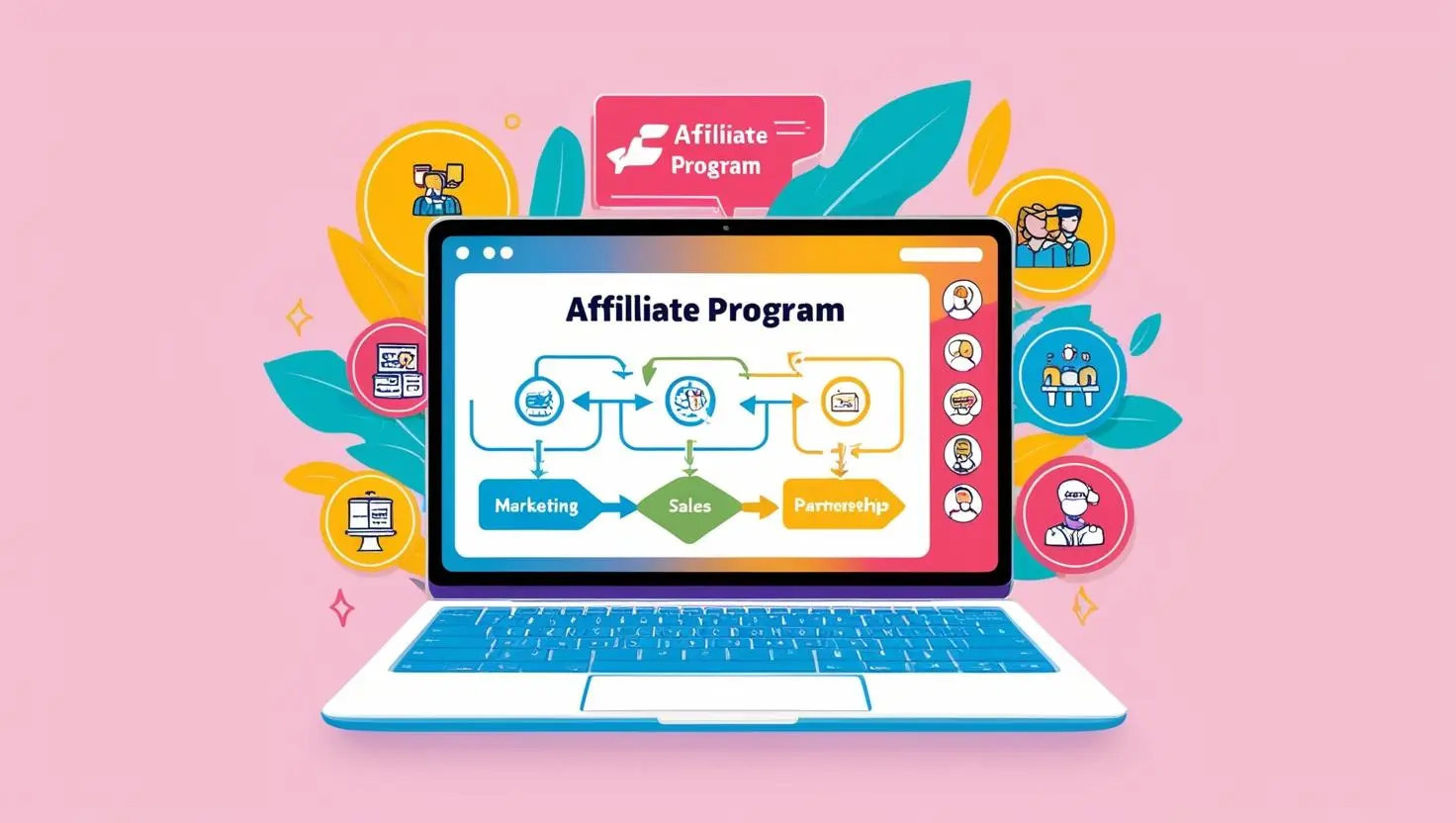Affiliate Sales Techniques

In the ever-evolving landscape of digital marketing, affiliate sales techniques have emerged as a powerful tool for brands and marketers alike to amplify their reach, drive sales, and foster meaningful partnerships. As consumers increasingly turn to online platforms for their purchasing decisions, mastering the art of affiliate marketing becomes crucial. This comprehensive guide delves into the nuances of affiliate sales techniques, offering insights and strategies to optimise your affiliate programme for maximum impact. Whether you’re a brand looking to expand your digital footprint or an affiliate marketer aiming to boost your commissions, understanding these techniques can significantly enhance your marketing efforts.
Understanding Affiliate Marketing
Affiliate marketing is a performance-based marketing strategy that has become a cornerstone in the digital marketing landscape. It involves a partnership between a brand and one or more affiliates, where the affiliate earns a commission for marketing the brand’s products or services and driving sales or leads. This mutually beneficial arrangement allows brands to extend their reach and leverage the audiences of their affiliates, while affiliates have the opportunity to earn income by promoting products or services they believe in.
The Basics of Affiliate Marketing
At its core, affiliate marketing is about relationships and value exchange. It comprises three primary entities: the advertiser (or merchant), the affiliate (or publisher), and the consumer. The advertiser provides the product or service, the affiliate promotes this to their audience, and the consumer is the end user who purchases the product or service via the affiliate’s marketing efforts.
The process begins when an affiliate joins an advertiser’s affiliate programme, often through an affiliate network that acts as an intermediary. Once accepted, the affiliate is provided with a unique affiliate link or code, which they use in their content—be it blog posts, social media updates, or email newsletters. When a consumer clicks on this link and makes a purchase or completes a desired action, the affiliate earns a commission. This commission structure incentivises affiliates to create high-quality, persuasive content that resonates with their audience.
Affiliate marketing thrives on transparency and trust. Affiliates must disclose their partnerships with brands, ensuring consumers are aware of the commercial relationship behind the recommendation. This transparency not only complies with regulatory standards but also fosters trust between the affiliate, their audience, and the brand.
The Role of Affiliates in Digital Marketing
Affiliates play a pivotal role in the broader digital marketing ecosystem. They act as an extended sales force for brands, using their platforms and influence to reach potential customers that the brands might not be able to engage with directly. This is particularly beneficial for brands looking to tap into niche markets or specific demographics.
By leveraging diverse content formats and digital channels—ranging from blogs and review sites to social media and video platforms—affiliates can provide personalised, content-driven marketing that speaks directly to the interests and needs of their audience. This targeted approach often results in higher engagement rates and more effective conversion compared to traditional advertising methods.
Moreover, affiliates contribute to a brand’s digital marketing efforts by enhancing its SEO through backlinks, generating valuable user-generated content, and increasing brand visibility and awareness. The performance-based nature of affiliate marketing also makes it a cost-effective strategy for brands, as they only pay for actual sales or qualified leads, reducing the risk associated with upfront marketing expenses.
In summary, affiliates are integral to digital marketing, offering a flexible, results-oriented approach that benefits both brands and marketers. Through strategic partnerships and creative marketing efforts, affiliate marketing continues to be a powerful tool in the digital marketing arsenal, driving sales and fostering connections between brands and consumers.

Setting Up an Affiliate Programme
Creating a successful affiliate programme involves careful planning and strategic decisions. Two of the most critical components in this process are selecting the appropriate affiliate platform and establishing a fair and motivating commission structure. These elements lay the foundation for a productive and mutually beneficial relationship between a brand and its affiliates.
Choosing the Right Affiliate Platform
The choice of an affiliate platform is pivotal in shaping the efficiency and effectiveness of your affiliate programme. An affiliate platform acts as the intermediary that facilitates the management of your affiliate relationships, tracking of sales and commissions, and communication with your affiliates. Here are some key considerations when choosing the right affiliate platform:
- Ease of Use: The platform should be user-friendly for both the brand and the affiliates, with a straightforward interface that simplifies management and tracking.
- Integration Capabilities: It’s essential to select a platform that integrates seamlessly with your existing website and eCommerce systems to ensure smooth operations.
- Tracking and Reporting: A robust tracking system that accurately records clicks, sales, and commissions is crucial. Detailed reporting capabilities will help you and your affiliates to understand performance and optimise strategies.
- Affiliate Management: Look for features that aid in the recruitment, onboarding, and ongoing management of affiliates, including communication tools and the ability to provide affiliates with promotional materials.
- Scalability: Consider whether the platform can accommodate your programme’s growth, both in terms of the number of affiliates and the volume of transactions.
- Support and Community: Good customer support for resolving technical issues and a vibrant community for networking and learning from other merchants and affiliates can be invaluable resources.
Selecting the right platform is about finding the best fit for your business’s specific needs, budget, and goals. Popular platforms include ShareASale, Commission Junction (CJ Affiliate), and Awin, each offering a unique set of features and benefits.
Defining Commission Structures
An attractive and equitable commission structure is essential to recruit and retain high-performing affiliates. Your commission model should not only motivate affiliates but also align with your business margins and marketing objectives. Consider the following when defining your commission structures:
- Percentage vs Fixed Amount: Decide whether to offer a percentage of each sale or a fixed amount per action (e.g., per sale or lead). Percentage commissions are common in product sales, while fixed amounts are often used for lead generation.
- Tiered Commissions: Implementing tiered commission levels based on performance metrics (such as sales volume or revenue) can incentivise affiliates to achieve higher targets.
- Cookie Duration: Cookie duration determines how long after a click an affiliate can earn commission on a sale. A longer duration is generally more attractive to affiliates.
- Product-Specific Commissions: If your range includes products with varying margins, consider setting different commission rates for different products or categories.
- Bonuses and Incentives: Offering bonuses for reaching certain thresholds or running promotional campaigns can boost affiliate engagement and performance.
It’s important to regularly review and adjust your commission structure based on market trends, your programme’s performance, and feedback from affiliates. A well-thought-out commission model will not only attract skilled affiliates but also ensure the long-term sustainability of your affiliate programme.

Recruiting the Right Affiliates
The success of an affiliate programme hinges significantly on the quality and compatibility of its affiliates. Identifying and recruiting the right affiliates involves strategic targeting and relationship building to ensure a mutually beneficial partnership. Here’s how you can identify potential affiliate partners and employ effective onboarding strategies to set them up for success.
Identifying Potential Affiliate Partners
The process of identifying potential affiliates should start with a clear understanding of your target audience and the types of content they consume. Here are some strategies to find suitable affiliate partners:
- Niche Websites and Bloggers: Look for content creators within your niche who share your target audience. Their established trust and influence can drive significant traffic and conversions.
- Social Media Influencers: Influencers with a strong presence on platforms like Instagram, YouTube, or TikTok can be powerful affiliates, leveraging their followers to promote your products.
- Product Review Sites: Websites that specialise in reviewing products in your industry can be excellent affiliates, as their content is often sought after by consumers in the decision-making process.
- Affiliate Networks: Joining an affiliate network can connect you with a vast pool of potential affiliates across various niches and industries.
- Existing Customers: Your loyal customers can be great advocates for your brand. Consider creating a referral programme to turn satisfied customers into affiliates.
- Competitor Affiliates: Researching affiliates promoting similar or complementary products can uncover potential partners who already understand your market.
When identifying potential affiliates, consider their content quality, audience engagement, and alignment with your brand values to ensure they are a good fit for your programme.
Effective Affiliate Onboarding Strategies
Once potential affiliates have been identified, the next step is to onboard them effectively to your affiliate programme. A smooth and informative onboarding process can significantly impact an affiliate’s ability to promote your products successfully. Here are some strategies for effective affiliate onboarding:
- Welcome Pack: Provide a comprehensive welcome pack that includes detailed information about your products, brand guidelines, and clear instructions on how to get started.
- Training Materials: Offer training materials such as tutorials, webinars, or e-courses to educate new affiliates about affiliate marketing best practices and how to effectively promote your products.
- Dedicated Support: Assign a dedicated affiliate manager or support team to assist with any queries or issues. Regular communication can help build a strong relationship with your affiliates.
- Marketing Assets: Supply affiliates with a range of marketing assets, including banners, product images, sample content, and promotional materials, to make it easier for them to create high-quality content.
- Performance Tracking: Ensure affiliates have access to a reliable tracking system where they can monitor their performance, track commissions, and analyse what strategies are working best.
- Feedback Mechanism: Implement a system for affiliates to provide feedback about the programme. This can help you identify areas for improvement and adapt your strategies to better meet their needs.
Effective onboarding not only equips affiliates with the tools and knowledge they need to succeed but also sets the tone for a productive and long-lasting partnership. By investing in the success of your affiliates, you’re more likely to see a positive impact on your affiliate programme’s overall performance.

Leveraging Affiliate Tools and Resources
To maximise the effectiveness of an affiliate programme, providing affiliates with the right tools and resources is crucial. These tools not only enhance the efficiency of affiliate marketing efforts but also empower affiliates to create more engaging and persuasive content. Let’s explore the essential tools for affiliates and strategies for creating compelling affiliate content.
Essential Tools for Affiliates
Affiliates need a suite of tools to streamline their marketing efforts, track their performance, and create high-quality content that converts. Here are some essential tools for affiliates:
- Affiliate Tracking Software: Tools like Post Affiliate Pro or Impact Radius offer sophisticated tracking solutions that allow affiliates to monitor clicks, conversions, and commissions in real-time.
- SEO Tools: Tools such as Ahrefs, SEMrush, or Moz are invaluable for keyword research, competitor analysis, and SEO optimisation, helping affiliates to improve their content’s visibility in search engines.
- Content Creation Tools: Canva, Adobe Spark, and similar platforms enable affiliates to create professional-looking graphics, videos, and other multimedia content with ease.
- Email Marketing Software: Platforms like Mailchimp or ConvertKit are essential for affiliates focusing on email marketing, providing features for list management, campaign automation, and performance tracking.
- Social Media Management Tools: Tools like Hootsuite or Buffer help affiliates to schedule posts, track engagement, and manage multiple social media accounts efficiently.
- Analytics Tools: Google Analytics and other analytics platforms are crucial for understanding audience behaviour, tracking referral traffic, and measuring the effectiveness of affiliate marketing strategies.
Providing access to or recommendations for these tools can significantly enhance the productivity and effectiveness of your affiliates’ marketing efforts.
Creating Engaging Affiliate Content
The success of affiliate marketing heavily relies on the quality and engagement level of the content produced by affiliates. Here are some strategies for creating engaging affiliate content:
- Understand the Audience: Affiliates should have a deep understanding of their audience’s needs, preferences, and pain points. This knowledge allows them to tailor their content to address specific interests and questions.
- Use Storytelling: Incorporating personal experiences, testimonials, or success stories can make affiliate content more relatable and persuasive. Storytelling can help to build trust and encourage audience engagement.
- Provide Value: Content that offers genuine value, such as how-to guides, tutorials, product comparisons, and insightful reviews, is more likely to engage readers and drive conversions.
- Incorporate Visuals: High-quality images, infographics, and videos can make content more appealing and easier to digest. Visuals can also help to highlight key features or benefits of the products being promoted.
- Optimise for SEO: Applying SEO best practices, including the use of relevant keywords, meta descriptions, and alt tags, can improve the visibility of affiliate content in search engine results.
- Engage on Social Media: Sharing content on social media platforms and engaging with followers can extend the reach of affiliate marketing efforts and drive traffic to the content.
By equipping affiliates with the right tools and encouraging the creation of engaging, value-driven content, brands can significantly enhance the impact of their affiliate marketing programme. Engaged audiences are more likely to convert, leading to higher sales and a stronger return on investment for both the brand and its affiliates.

Affiliate Marketing Strategies for Maximum Engagement
Engaging potential customers through affiliate marketing requires a blend of strategic SEO optimisation and the effective use of social media and influencers. By focusing on these areas, affiliates can enhance their visibility, drive traffic, and ultimately increase conversions. Here’s how affiliates can leverage these strategies for maximum engagement.
SEO Optimisation for Affiliate Content
SEO optimisation is crucial for ensuring your affiliate content ranks well in search engine results, making it more likely to be seen by your target audience. Here are key SEO strategies for affiliate marketers:
- Keyword Research: Begin with comprehensive keyword research to understand the terms and phrases your target audience uses when searching for products or services in your niche. Tools like Google Keyword Planner or SEMrush can provide valuable insights.
- Quality Content: Create high-quality, informative content that addresses the needs and questions of your audience. Content that adds value, such as how-to guides, tutorials, and product reviews, can improve your SEO rankings and attract more traffic.
- On-Page SEO: Ensure your content is optimised for search engines by including target keywords in strategic places such as the title, headings, meta descriptions, and throughout the body of your content. However, avoid keyword stuffing, which can negatively impact your SEO.
- Backlinks: Acquiring backlinks from reputable sites within your niche can significantly boost your content’s authority and search engine rankings. Consider guest posting or collaborating with other websites to build your backlink profile.
- Mobile Optimisation: With the increasing prevalence of mobile searches, ensure your content is mobile-friendly. Google’s Mobile-Friendly Test can help you assess your site’s performance on mobile devices.
- Loading Speed: Page loading speed is a critical SEO factor. Use tools like Google PageSpeed Insights to evaluate and improve your site’s loading times.
Utilising Social Media and Influencers
Social media and influencer partnerships can amplify your affiliate marketing efforts, providing a platform to engage directly with your audience and leverage the trust and authority of influencers in your niche.
- Choose the Right Platforms: Focus on social media platforms where your target audience is most active. Whether it’s Instagram, YouTube, Twitter, or Facebook, each platform has unique features and audiences.
- Engagement: Regularly engage with your audience by responding to comments, asking questions, and creating interactive content such as polls and quizzes. This can build a loyal following and increase the likelihood of your content being shared.
- Collaborate with Influencers: Partner with influencers who share your target audience and values. Influencers can introduce your content to a broader audience and lend credibility to the products or services you’re promoting.
- Leverage Stories and Live Features: Use Instagram Stories, Facebook Live, and other real-time content features to connect with your audience more personally and authentically. These formats are ideal for sharing behind-the-scenes content, product demonstrations, and Q&A sessions.
- Social Media Ads: Consider using social media advertising to boost the visibility of your top-performing content. Targeted ads can help you reach a larger or more specific audience.
- Consistency and Branding: Maintain a consistent posting schedule and visual branding across your social media profiles to build recognition and trust with your audience.
By integrating SEO best practices with strategic social media and influencer collaborations, affiliates can significantly enhance the reach and engagement of their content, driving more traffic and conversions for their affiliate marketing campaigns.

Performance Tracking and Analytics
In the dynamic realm of affiliate marketing, tracking performance and analysing data are indispensable for understanding the effectiveness of your campaigns and making informed decisions. By setting clear Key Performance Indicators (KPIs) and rigorously analysing affiliate marketing data, you can optimise your strategies for better results.
Setting Key Performance Indicators (KPIs)
KPIs are quantifiable metrics that help you measure the success of your affiliate marketing efforts against your objectives. Selecting the right KPIs is crucial for assessing performance and guiding strategic adjustments. Here are essential KPIs for affiliate marketing:
- Conversion Rate: This measures the percentage of users who take a desired action (such as making a purchase) after clicking on an affiliate link. A high conversion rate indicates effective affiliate content and targeting.
- Click-Through Rate (CTR): CTR is the ratio of users who click on an affiliate link to the total number of users who view the link. It helps gauge the effectiveness of your affiliate content or ads in driving user engagement.
- Average Order Value (AOV): AOV tracks the average spending per customer transaction through affiliate links. Understanding AOV can help you evaluate the economic value of your affiliate traffic.
- Return on Investment (ROI): ROI measures the profitability of your affiliate campaigns, calculated as the return generated from affiliate sales divided by the cost of the affiliate programme.
- Affiliate Traffic: Monitoring the volume of traffic affiliates drive to your site is vital for assessing their performance and the overall impact of your affiliate programme.
- Commission Earned: Tracking the total commissions paid out to affiliates provides insights into the cost-effectiveness of your affiliate programme.
Analysing Affiliate Marketing Data
Once you’ve established your KPIs, the next step is to analyse the data to uncover insights and identify areas for improvement. Here’s how to approach affiliate marketing data analysis:
- Utilise Analytics Tools: Leverage tools like Google Analytics and affiliate platform dashboards to collect and analyse data. Ensure you have proper tracking in place to accurately attribute conversions to the right affiliates.
- Segmentation: Break down data by affiliate, campaign, product, or other relevant dimensions to identify which elements are performing best and why.
- Trend Analysis: Look for trends over time, such as seasonal variations or shifts in consumer behaviour, to inform your affiliate marketing strategy.
- A/B Testing: Conduct A/B tests on various elements of your affiliate programme, such as landing pages, affiliate content, and promotional offers, to determine what works best.
- Competitor Benchmarking: Compare your performance against industry benchmarks or competitors to understand your standing in the market and identify potential areas for improvement.
- Feedback Loop: Incorporate feedback from affiliates and customers to gain qualitative insights that complement your data analysis. This can reveal opportunities to enhance your affiliate programme and address any issues.
Regularly tracking and analysing these KPIs and other relevant data points will enable you to make data-driven decisions, optimise your affiliate marketing strategies, and ultimately achieve better results from your affiliate programme.

Optimising Affiliate Relationships
The foundation of a successful affiliate programme lies not only in its structure and strategy but also in the strength of its relationships. Optimising these relationships involves maintaining open communication and providing incentives and rewards that motivate and acknowledge affiliate efforts. Here’s how you can build and sustain productive relationships with your affiliates.
Maintaining Open Communication
Open and transparent communication is key to nurturing strong relationships with your affiliates. It involves more than just regular updates; it’s about creating a two-way dialogue where feedback and ideas are actively exchanged. Here’s how you can maintain effective communication:
- Regular Updates: Keep your affiliates informed about new products, changes to the affiliate programme, and upcoming promotions or sales events. Regular newsletters or email updates can be an effective way to stay in touch.
- Dedicated Support: Provide affiliates with a dedicated point of contact, such as an affiliate manager, who can address queries, offer assistance, and provide guidance. This helps in building trust and loyalty.
- Feedback Channels: Establish clear channels through which affiliates can provide feedback or express concerns. Whether it’s through surveys, direct emails, or a dedicated section in your affiliate portal, make it easy for affiliates to share their thoughts with you.
- Affiliate Forums or Communities: Creating a space, such as an online forum or a private social media group, where affiliates can interact with each other and your brand can foster a sense of community and belonging.
Providing Incentives and Rewards
Incentives and rewards are powerful tools for motivating affiliates and encouraging top performance. They can take various forms, from financial bonuses to recognition programmes. Here are some strategies for incentivising your affiliates:
- Performance Bonuses: Offer bonuses for reaching specific milestones, such as a set number of sales or a high level of revenue within a certain period. This can motivate affiliates to increase their efforts.
- Tiered Commissions: Implement a tiered commission structure where affiliates can earn higher percentages based on their performance levels. This not only rewards top performers but also encourages others to aspire to higher tiers.
- Exclusive Promotions: Provide affiliates with exclusive deals or promotional codes they can offer to their audience. This adds value to their content and can help increase conversions.
- Recognition Programs: Recognise and celebrate your top-performing affiliates through public acknowledgment, awards, or features in your communications. Recognition can be a strong motivator and helps build a positive relationship.
- Affiliate Contests: Organise contests or challenges with prizes for top performers. This can create a friendly competition among affiliates and drive increased performance.
By maintaining open communication and providing incentives and rewards, you can cultivate a supportive and motivating environment for your affiliates. This not only enhances their performance but also strengthens their loyalty to your brand, contributing to the long-term success of your affiliate programme.

Scaling Your Affiliate Programme
As your affiliate programme begins to show success, the next logical step is to scale it to amplify your reach and revenue. Expanding your affiliate network and diversifying the channels through which affiliates promote your products are strategic ways to achieve this growth. Here’s how you can effectively scale your affiliate programme.
Expanding Your Affiliate Network
Growing your network involves more than just increasing the number of affiliates; it’s about strategically partnering with affiliates who can reach diverse and relevant audiences. Here are some steps to expand your affiliate network effectively:
- Recruitment Campaigns: Launch targeted recruitment campaigns to attract new affiliates. This can involve using social media, attending industry events, or leveraging affiliate networks to find potential partners who align with your brand.
- Referral Programmes: Encourage current affiliates to refer others to your programme. Offering a bonus for successful referrals can motivate your existing affiliates to help grow your network.
- Diverse Affiliates: Look beyond traditional content creators and consider partnering with non-traditional affiliates like software companies, service providers, or even customers who can bring unique value to your programme.
- Global Expansion: If your business operates internationally, consider recruiting affiliates from different geographical regions to tap into new markets and audiences.
Diversifying Affiliate Marketing Channels
Relying on a single channel or type of affiliate can limit your programme’s potential. Diversifying the channels through which your affiliates promote your products can help you reach a broader audience and mitigate risks. Here’s how to diversify your affiliate marketing channels:
- Influencer Partnerships: Collaborate with influencers across various platforms (Instagram, YouTube, TikTok) to reach different demographics and niches.
- Content Platforms: Encourage affiliates to use a mix of content platforms, from blogs and websites to podcasts and video channels, to cater to different audience preferences.
- Email Marketing: Work with affiliates who have strong email lists to promote your products through newsletters and dedicated email campaigns.
- Paid Advertising: Some affiliates may have expertise in running paid advertising campaigns. Providing them with branded assets and guidelines can help them create effective ads that complement your own marketing efforts.
- Social Media Diversity: Ensure your affiliates are present on multiple social media platforms to maximise your brand’s exposure across the digital landscape.
Scaling your affiliate programme requires careful planning and a strategic approach to both affiliate recruitment and channel diversification. By expanding your affiliate network and encouraging the use of various marketing channels, you can significantly increase the reach and impact of your affiliate marketing efforts, driving more sales and contributing to the overall growth of your business.

Common Challenges in Affiliate Marketing
Affiliate marketing, while highly effective, comes with its set of challenges that can impact the success and integrity of your programme. Among these, navigating the complex landscape of compliance and regulations, and mitigating the risks of affiliate fraud are paramount. Understanding these challenges and implementing strategies to address them is crucial for maintaining a trustworthy and successful affiliate programme.
Navigating Compliance and Regulations
Compliance with legal standards and regulations is critical in affiliate marketing to ensure ethical practices and avoid potential legal ramifications. Here’s how to navigate these complexities:
- Disclosure Requirements: Ensure that all affiliates understand the importance of disclosing their affiliate relationship with your brand in their content. This transparency is not just ethical; in many jurisdictions, it’s a legal requirement to comply with consumer protection laws.
- Data Privacy Regulations: With regulations like GDPR in the EU and similar laws in other regions, it’s crucial to ensure that your affiliate programme complies with data protection and privacy laws. This includes how affiliates collect, use, and manage data in their marketing activities.
- Advertising Standards: Affiliate promotions must adhere to advertising standards, avoiding misleading claims or deceptive practices. Regularly review affiliate content to ensure it meets these standards and reflects your brand accurately.
- Contractual Agreements: Clear, comprehensive affiliate agreements can help ensure that affiliates are aware of and comply with relevant laws and regulations. These agreements should cover aspects like promotional methods, intellectual property usage, and compliance requirements.
Addressing Affiliate Fraud
Affiliate fraud can significantly undermine the integrity and effectiveness of your programme. It includes any deceptive practice that unfairly inflates affiliate commissions. Here are strategies to detect and prevent affiliate fraud:
- Monitoring and Detection: Implement robust monitoring systems to track unusual patterns or anomalies in affiliate activity. Look out for signs like sudden spikes in traffic, high numbers of clicks with low engagement, or unusual patterns in referral sources.
- Clear Policies: Establish clear policies defining what constitutes fraudulent activity within your programme. Make sure these policies are communicated to all affiliates and that they understand the consequences of violating them.
- Regular Audits: Conduct regular audits of affiliate activities to verify the legitimacy of the transactions. This can involve reviewing high-commission transactions or investigating affiliates with unusually high conversion rates.
- Technological Solutions: Utilise technology and software designed to detect fraudulent activities. Many affiliate marketing platforms come equipped with fraud detection features that can help identify and prevent fraudulent activities.
- Vetting Affiliates: Implement a thorough vetting process for new affiliates to ensure they are reputable and have a legitimate audience. This can involve reviewing their online presence, content quality, and audience engagement.
By proactively addressing the challenges of compliance, regulations, and fraud, you can safeguard your affiliate programme, maintain its integrity, and ensure its long-term success. These efforts not only protect your brand but also foster a fair and transparent environment for all genuine affiliates.

Future Trends in Affiliate Marketing
The landscape of affiliate marketing is continuously evolving, shaped by advances in technology, shifts in consumer behaviour, and the emergence of new platforms. Staying ahead of these trends is crucial for marketers and affiliates alike to adapt their strategies for future success. Here’s a glimpse into the future trends in affiliate marketing.
Emerging Technologies and Platforms
The integration of new technologies and platforms is set to redefine the affiliate marketing space, offering innovative ways to connect with audiences and measure campaign effectiveness.
- Artificial Intelligence (AI) and Machine Learning: AI and machine learning are becoming increasingly prevalent in affiliate marketing, offering sophisticated tools for personalisation, predictive analytics, and automated decision-making. These technologies can help in identifying the most effective affiliate partners and optimising campaign performance.
- Voice Search and Smart Assistants: With the rise of voice-activated devices, optimising affiliate content for voice search is becoming important. Affiliates will need to adapt their SEO strategies to target conversational queries and long-tail keywords.
- Blockchain Technology: Blockchain could introduce greater transparency and trust into affiliate marketing by securely and transparently tracking transactions and ensuring fair compensation.
- Augmented Reality (AR) and Virtual Reality (VR): These immersive technologies offer new avenues for product promotion and engagement, allowing affiliates to create unique and interactive experiences for their audience.
Adapting to Changing Consumer Behaviours
Understanding and adapting to the changing preferences and behaviours of consumers is crucial for the continued effectiveness of affiliate marketing strategies.
- Demand for Authenticity: Consumers are increasingly seeking authenticity and transparency from brands and influencers. Affiliates who provide honest, unbiased reviews and content are likely to resonate more with audiences.
- Increased Mobile Usage: The shift towards mobile-first browsing and shopping means affiliates must ensure their content and promotional strategies are optimised for mobile devices, offering seamless experiences across all platforms.
- Privacy and Data Security: With growing concerns around data privacy, affiliates and marketers will need to navigate the fine line between personalisation and privacy, ensuring their tactics comply with regulations like GDPR and respecting consumer preferences.
- Sustainability and Social Responsibility: An increasing number of consumers are prioritising sustainability and ethical practices in their purchasing decisions. Affiliates promoting products and brands that align with these values may find greater success.
As we look to the future, affiliate marketing will continue to be influenced by technological advancements and changing consumer dynamics. Marketers and affiliates who stay informed about these trends and adapt their strategies accordingly will be well-positioned to thrive in this evolving landscape.
Conclusion
Affiliate marketing presents a dynamic and effective avenue for brands and marketers to drive sales and build lasting partnerships. By understanding and implementing the right affiliate sales techniques, businesses can significantly enhance their marketing strategies, reaching a wider audience and achieving their sales objectives. From selecting the appropriate affiliates to leveraging advanced tools and analytics, each aspect of an affiliate programme requires careful consideration and strategic planning. As the digital landscape continues to evolve, staying abreast of the latest trends and innovations in affiliate marketing will be key to maintaining a competitive edge.